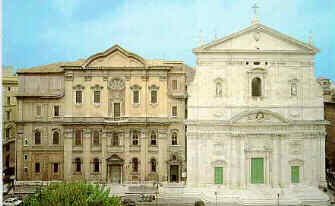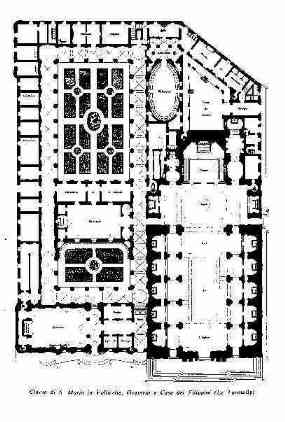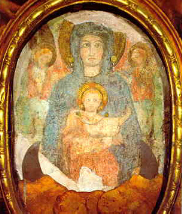 The Chiesa Nuova (New Church) is one part of a large complex which was
built in several stages beginning in 1575, to accommodate the work of St.Philip
Neri and, after his death, the work of the Congregation of the Oratory
The complex, which today is comprised of the church, the Secular Oratory,
the Vallicella Library and the Convent of the Congregation, is situated
within the historic center of Rome.
The Chiesa Nuova (New Church) is one part of a large complex which was
built in several stages beginning in 1575, to accommodate the work of St.Philip
Neri and, after his death, the work of the Congregation of the Oratory
The complex, which today is comprised of the church, the Secular Oratory,
the Vallicella Library and the Convent of the Congregation, is situated
within the historic center of Rome. The Vallicella, from which the church takes its name, was originally a small valley which corresponded to the ancient Tarentum Romano. It was known in its time as an unhealthy place, full of stagnant water, where the Romans had raised an altar to Proserpina. Although this small valley was not considered the most healthy place in Rome, the area, because of its position near the path of the pilgrims who arrived in the Eternal City, developed remarkably after the year 1000.
 In the 1500s the area was referred to as "al pozzo bianco", filled
with small houses, high medieval towers and several small churches, among
which was the early S. Maria in Vallicella built upon a foundation of Pope
St.Gregory the Great in the 6th century. In this church was kept a miraculous
image of the Virgin, an object greatly venerated by the people of Rome.
In the 1500s the area was referred to as "al pozzo bianco", filled
with small houses, high medieval towers and several small churches, among
which was the early S. Maria in Vallicella built upon a foundation of Pope
St.Gregory the Great in the 6th century. In this church was kept a miraculous
image of the Virgin, an object greatly venerated by the people of Rome.With the formation of the Congregation, Pope Gregory XIII gave to St.Philip the ancient church of the Vallicella, as the home of the Oratory, and entrusted the ancient church to his care. When St.Philip and his followers arrived to take up residence, the church was a small, simple building, hardly in keeping with the needs of faithful of the time. With the passage of the, the little church had begun to fail into disrepair.
To make the church a fitting place for worship, with all improvement called for by the recently convened Council of Trent, St. Philip decided to rebuild the church from its foundations. Relying upon Divine Providence to find the money necessary, St.Philip began the imposing project with 300 scudi offered by St.Charles Borromeo. St. Charles, another great figure of this period, regarded St. Philip with deep admiration and devotion.
On September 17, 1575, accompanied by all the grandeur of a solemn liturgy, the cornerstone of the new church was laid by the Archbishop of Florence, Alessandro de' Medici, the future Pope Leo XI.
The project of building the Chiesa Nuova was, first entrusted to Matteo da Cittą di Castello, who was eventually succeeded by Marino Lunghi il Vecchio.
The work, which took place in several stages, soon allowed for the opening of the central nave for liturgical celebrations. In the newly built Chapel of the Annunciation, St. Philip continued his work of spiritual direction, as long as his strength allowed. The new church reflected throughout, the style and personality of the Saint, who with his characteristic simplicity, wished for the main nave to be kept white-washed. His Marian devotion prompted the dedication of all the side altars to the Virgin, emphasizing, among other things, the ancient namesake of the church, which for centuries had been dedicated solely to the Virgin.
 At the wish of St. Philip, the ancient image of St. Maria in Vallicella,
that has with the time become the emblem of the Congregation of the Oratory,
was transferred to the interior of the Chiesa Nuova. Today, this icon is
located in a special niche, above the main altar. On Sundays and solemnities, the painting of the Virgin and Child by Peter Paul Rubens (seen in the
oval above the main altar) is removed to reveal the miracolous image.
At the wish of St. Philip, the ancient image of St. Maria in Vallicella,
that has with the time become the emblem of the Congregation of the Oratory,
was transferred to the interior of the Chiesa Nuova. Today, this icon is
located in a special niche, above the main altar. On Sundays and solemnities, the painting of the Virgin and Child by Peter Paul Rubens (seen in the
oval above the main altar) is removed to reveal the miracolous image.In 1605, after the death of St. Philip, the facade was completed. The completion of the other buildings, in the complex and the final decoration of the interior of the church were carried out over the following centuries. The church, by this time complete, was filled with the works of the most prestigious artists of the l6th century: Caravaggio, Rubens, Federico Barocci and Pietro da Cortona. In the 18th century the interior of the nave was enriched, with the ornament and gold stucco that we see today.